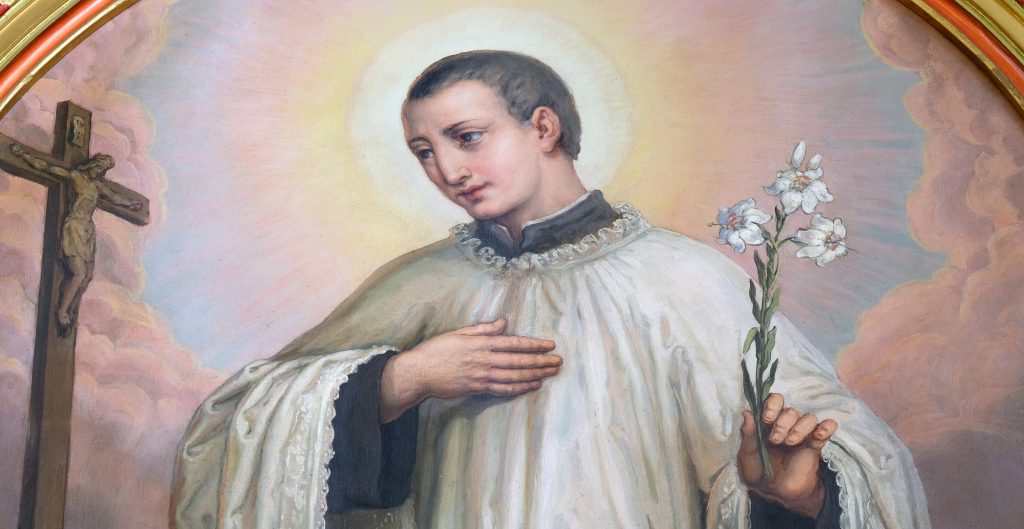Born into an aristocratic family in 1568, St. Aloysius Gonzaga was destined to succeed his father’s noble position. As such, he was enrolled in a boot camp at age 5 (where he gained a certain vocabulary much to his mother and tutor’s dismay). In addition to witnessing the political turmoil, depravity and violence of Renaissance society, Gonzaga also lived through the murder of his two brothers.
But Gonzaga’s life began to change when he started to develop a relationship with the Lord after he started to suffer from kidney problems around age 8. Suddenly, he had plenty of time available for spiritual reading and prayer. The following year, Gonzaga took a vow of chastity. He also became greatly inspired by reading about Jesuit missionaries to India and found himself drawn to that vocation.
After Gonzaga made known his calling to serve as a missionary priest, those closest to him tried to dissuade him. Seeing the futility of their attempts to steer him away from priesthood, Gonzaga’s family thought they could convince him to stay away from a religious order with the promise to secure his advancement as a bishop. None of that seemed attractive or tempting to him. Instead, he renounced his inheritance and set out to serve Christ and the Church in the Society of Jesus. Of course, Gonzaga knew there was a greater inheritance awaiting him: “It is better to be a child of God than king of the whole world,” he said.
Interestingly, Gonzaga was encouraged and supported by two great saints: St. Charles Borromeo (1538-1584) — from whom Gonzaga received his first holy Communion — and St. Robert Bellarmine. The latter was Gonzaga’s own Jesuit confrere, but more importantly, an influential spiritual father and confessor.
Gonzaga gradually came to know the connection between love and suffering, which is bound up in Christ’s cross. “He who wishes to love God does not truly love him if he has not an ardent and constant desire to suffer for his sake,” he said. Gonzaga’s ill health worsened not long after he joined the Jesuits in 1585. He was burdened by other ailments, in addition to kidney disease, including recurring headaches and difficulty sleeping. In 1590, he received a vision from St. Gabriel the Archangel, in which he learned he would die within the year ahead.
The next year a plague struck Rome. Despite his own infirmities, Gonzaga was quick to offer help to the epidemic’s victims. Carrying them off the streets and to the hospital established by the Jesuits, Gonzaga brought consolation and comfort to the sick and dying. Not only did he bathe and care for the sick, but he did his best to tend to their spiritual needs as well. He was forbidden by superiors from continuing the work after many of his Jesuit confreres were afflicted by the disease.
Later, Gonzaga was allowed to minister at a hospital for those without infectious diseases, or so it was thought. After serving a man who turned out to be suffering from the plague, Gonzaga took ill himself. Although it appeared he might recover, his fever and cough worsened, and his health steadily deteriorated over the course of several weeks. The Jesuit scholastic Gonzaga lived what St. Robert Bellarmine taught: “The school of Christ is the school of love.”
St. Robert Bellarmine assisted Gonzaga spiritually in his last trial, regularly bringing him the sacraments. He recalled that Gonzaga did not fear death, but that “he longed to be freed from his flesh and to come to Christ.” Gonzaga died on June 21, 1591 with the name of Jesus on his lips.
Bellarmine worked to promote his disciple’s beatification, which came just 14 years after Gonzaga’s death, extolling his virtues, especially his patience and humility. Their bodies rest near each other in the Roman church of St. Ignatius of Loyola.
St. Aloysius Gonzaga is commemorated on June 21.
Michael R. Heinlein is editor of Simply Catholic. Follow him on Twitter @HeinleinMichael.

